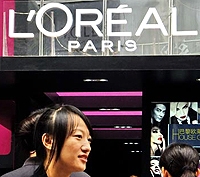Reflecting an astute strategy allowing both the better penetration of the China market through an already well established domestic player, and canny product diversification, L’Oréal is poised to acquire Magic Holdings, China’s facial mask segment leader, with its MG brand.
The advantages of this acquisition are manifold. Although a young company, Magic Holdings has been growing at a remarkable pace over its first five years, and it now dominates over a quarter of the facial mask market. The company will supplement its two existing factories with a new production facility, slated to come into operation in 2015, and bringing with it an expected 50% plus production capacity and enhancing its economies of scale. Given the absence of a facial mask line within L’Oréal’s existing product portfolio, this acquisition—pending approval by the Ministry of Commerce of the People’s Republic of China— will therefore enhance and extend L’Oreal’s product range as a significant asset.
The acquisition follows L’Oréal’s earlier smaller but equally pragmatic forays into the Chinese market. The purchase of local brands, Mininurse in 2003 and Yue-Sai in 2004, gave the company the opportunity to better access and more thoroughly engage in this market. The Mininurse acquisition secured L’Oréal a production facility in China (Yichang, Hebei), which subsequently expanded significantly, while the Yue-Sai deal encompassed a facility in Shanghai, conveniently neighboring L’Oréal’s R&D center.
Like the pending Magic Holdings acquisition, both the Mininurse and Yue-Sai deals appeared to be designed to buy into either a leading position of growth and/or broadening the French giant’s demographic and socioeconomic market reach. Mininurse, distinctly lower-end and mass-market, subsequently delivered suboptimal returns, with L’Oréal China’s late president, Paolo Gasparrini, admitting that L’Oréal did not realize its initial goals in developing the brand. However, Alexis Perakis-Valat, L’Oréal’s Executive Vice President for the Asia Pacific Zone recently noted, “We have faced some challenges [concerning Mininurse] but we have not given up. On top of the work on the brand, it is important to note that we have developed the original factory in Yichang as L’Oréal Asia’s production center for color cosmetics.”
By contrast, Yue-Sai, positioned around traditional Chinese medicine and conspicuously using Chinese herbs and mushrooms (Ganoderma in particular), is resonating well in China and enjoys above-average growth. This correlates with Kline’s recent findings, indicating that in 2013 the Chinese natural personal care market is heading for a growth of almost 25%. This segment is explored in greater detail in Kline’s report, Natural Personal Care: China.
L’Oréal has likely learned valuable lessons from both acquisitions, and may be planning to make Magic Holdings into a more straightforward success. Coupled with a strategy that includes products targeting China’s men—a particularly fast-growing market segment—the Magic Holdings acquisition will eventually help further boost the company’s China sales beyond the 10% growth aimed for in 2013.
For a comprehensive analysis of the retailing environment for cosmetics and toiletries within China and three other major markets in Asia, Kline offers insights from its upcoming report, Beauty Retailing Asia: Channel Analysis and Opportunities. Additionally, for insights into China’s natural personal care and male grooming products, view Kline’s recently published reports, Male Grooming Products: Global Market Brief and Natural Personal Care: China.
A compelling perspective on the cosmetics market in Asia will be presented by Kline’s China-based Rob Field-Marsham at the “Global Personal Care Ingredients: Asia Focus” seminar at in-cosmetics Asia in Gyeonggi, South Korea, on September 12, 2013.

